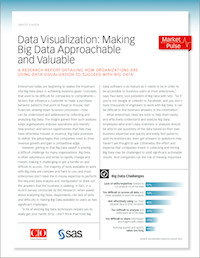
Enterprises today are beginning to realize the important role Big Data visualization plays in achieving business goals. Concepts that used to be difficult for companies to comprehend— factors that influence a customer to make a purchase, behavior patterns that point to fraud or misuse, inefficiencies slowing down business processes now can be understood and addressed by collecting and analyzing Big Data. The insight gained from such analysis helps organizations improve operations and identify
new product and service opportunities that they may have otherwise missed. In essence, Big Data promises to deliver the advantages that companies need to drive revenue growth and gain a competitive edge.
However, getting to that Big Data payoff is proving
a difficult challenge for many organizations. Big Data Visualization
is often voluminous and tends to rapidly change and morph, making it challenging to get a handle on and difficult to access. The majority of tools available to work with Big Data are complex and hard to use, and most enterprises don’t have the in-house expertise to perform the required data analysis and manipulation to draw out the answers that the business is seeking. In fact, in a recent survey conducted by IDG Research, when asked about analyzing Big Data, respondents cite lack of skills and difficulty in making Big Data available to users as two significant challenges.
“A lot of existing Big Data techniques require you to really get your hands dirty; I don’t think that most Big
Data software is as mature as it needs to be in order to be accessible to business users at most enterprises,” says Paul Kent, vice president of Big Data with SAS. “So if you’re not Google or LinkedIn or Facebook, and you don’t have thousands of engineers to work with Big Data, it can be difficult to find business answers in the information.”
What enterprises need are tools to help them easily and effectively understand and analyze Big Data. Employees who aren’t data scientists or analysts should be able to ask questions of the data based on their own business expertise and quickly and easily find patterns, spot inconsistencies, even get answers to questions they haven’t yet thought to ask. Otherwise, the effort and expense that companies invest in collecting and mining Big Data may be challenged to yield significant actionable results.
All information that you supply is protected by our privacy policy. By submitting your information you agree to our Terms of Use.
* All fields required.



